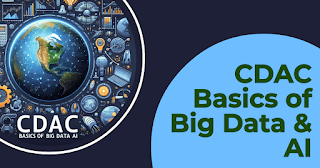CDAC Basics of Big Data & AI: A Guide for Aspiring Technologists
Hello there, future technologists! If you’re reading this, you’re probably preparing for the CDAC’s PG-Diploma entrance exam, also known as the C-CAT. This blog post will provide you with a basic understanding of two key areas: Big Data and Artificial Intelligence (AI). Let’s dive in!
Big Data: The Giant of Information
Big Data is a term that refers to extremely large datasets that are difficult to manage using traditional data processing tools. It’s like a giant library with millions of books, but imagine if those books were constantly growing in number and size!
Why is Big Data Important?
In today’s digital age, we generate a massive amount of data every second. This data comes from various sources like social media, sensors, machines, and more. By analyzing this data, we can gain valuable insights that can help in making strategic decisions.
Key Concepts of Big Data
Volume: This refers to the amount of data. In Big Data, we’re dealing with large volumes of data that can reach up to zettabytes or even yottabytes!
Velocity: This is the speed at which data is generated and processed. In many cases, this data needs to be analyzed in real-time.
Variety: This refers to the different types of data we can have. It can be structured (like databases), semi-structured (like XML files), or unstructured (like text files or social media posts).
Artificial Intelligence: The Brain Behind the Machine
Artificial Intelligence, or AI, is a field of computer science that aims to create machines that mimic human intelligence. Think of it as teaching a machine how to think and learn from its experiences.
Why is AI Important?
AI has the potential to revolutionize various sectors, including healthcare, finance, transportation, and more. It can automate tasks, improve efficiency, and even make predictions based on patterns.
Key Concepts of AI
Machine Learning: This is a subset of AI where machines learn from data without being explicitly programmed. It’s like teaching a child how to walk. You don’t specifically instruct them on how to move each leg. They learn it over time by themselves.
Deep Learning: This is a type of machine learning that models algorithms based on the human brain called artificial neural networks. It’s used for more complex tasks like image recognition, natural language processing, etc.
Natural Language Processing (NLP): This involves the interaction between computers and human language. It allows machines to understand, interpret, and generate human language.
Preparing for the CDAC C-CAT Exam
Now that you have a basic understanding of Big Data and AI, you’re one step closer to cracking the CDAC C-CAT exam. Remember, understanding these concepts is just the beginning. Practice is key. Solve as many sample papers and mock tests as you can. This will not only help you understand the exam pattern but also improve your speed and accuracy.
Remember, Rome wasn’t built in a day. So, take one step at a time and keep learning. Good luck with your preparations!
JOIN OUR TELEGRAM CHANNEL TO GET THE Basics of Big Data & AI Books
https://t.me/+Q1gBk0WuYmt8xkY-
Note: This blog post is intended to provide a basic understanding of Big Data and AI. For a more in-depth study, refer to the recommended textbooks and resources provided by CDAC.
